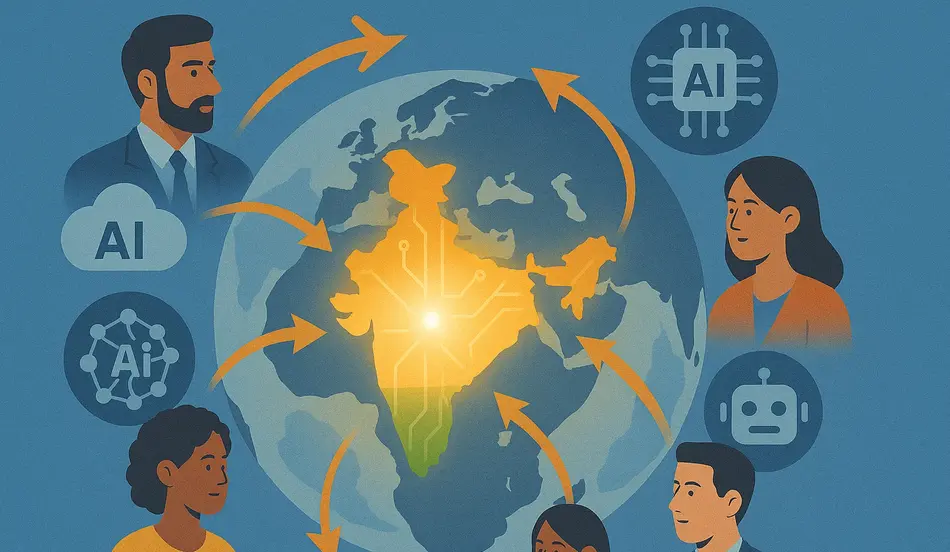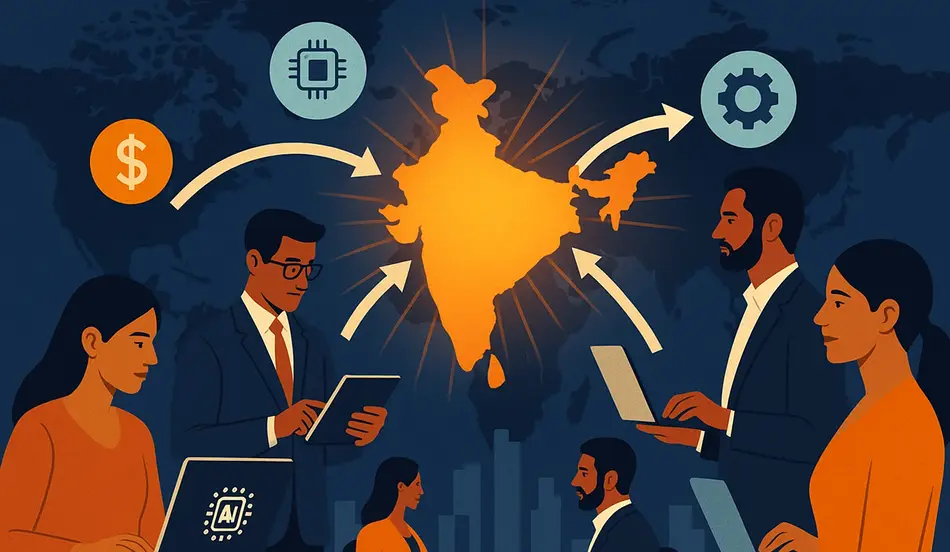India stands as one of the most resilient economies in today’s challenging global landscape, with its influence projected to grow consistently throughout this century. According to economic experts, India has positioned itself as a standout performer during these turbulent times, doubling its GDP over the last decade alone. If the country maintains its growth trajectory between 6-7% in the coming years, it will rapidly transform into a $10 trillion economy, significantly enhancing India’s global economic influence in the AI jobs marketplace.
The country’s economic resilience stems from a combination of factors, including its diverse economic base, growing domestic market, and strategic positioning in global supply chains. As World Economic Forum research indicates, India’s economic stability during recent global disruptions has strengthened its position as an attractive destination for international investment.
The Strategic Shift in Global Supply Chains
The global manufacturing landscape is experiencing a dramatic transformation, with India emerging as a prime beneficiary of “friendshoring” initiatives. A striking example of this shift is the iPhone production ecosystem – just a few years ago, no iPhones were manufactured in India, but today the country accounts for approximately 25% of global iPhone production. This remarkable transition highlights how India’s global economic influence is reshaping AI jobs and manufacturing priorities worldwide.
However, this transition isn’t without challenges. Recent statements from the US administration suggest a preference for domestic manufacturing of these technologies, indicating potential friction in the evolving global supply chain dynamics that could impact India’s global economic influence on AI jobs creation.
The Demographic Dividend: India’s Unique Advantage
India possesses a significant competitive edge through its demographic profile, with a median age of just 28 years. This youthful population represents a growing workforce that brings technological savvy and adaptability to the rapidly evolving digital landscape.
Balancing Growth with Employment in the AI Era
One of the most pressing challenges facing India is creating sufficient employment opportunities for the millions entering the job market each month. This demographic bulge presents both a challenge and an opportunity in the age of artificial intelligence, where traditional employment patterns are being disrupted globally.
The question of how India can maintain robust economic growth while ensuring adequate job creation is central to its development strategy. This balancing act is particularly crucial as India’s global economic influence in AI jobs continues to expand, requiring thoughtful policy approaches that maximize opportunities while mitigating potential disruptions.
AI: Threat or Opportunity for India’s Workforce?
Artificial intelligence represents a paradigm shift in technology with profound implications for employment patterns worldwide. However, rather than viewing AI solely as a threat to jobs, experts suggest it should be seen as a catalyst for transformation in the labor market.
🤖 AI Is Reshaping Work — Are You Ready?
Artificial intelligence is transforming the global workforce, creating exciting new roles across industries.
Discover future-ready jobs in AI, Machine Learning, Computer Science, and Emerging Technologies that align with tomorrow’s innovation economy.
WhatJobs connects forward-thinking professionals with in-demand opportunities designed for the age of intelligent automation.
👉 Explore AI-driven tech jobs now and future-proof your career.The Productivity Promise of AI Implementation
AI offers unprecedented potential for productivity enhancement, with economists projecting that proactive implementation could boost productivity by up to 10% – gains unseen for decades. This productivity increase translates directly to prosperity, enabling the production of more goods and services with fewer resources, creating economic surplus that can be reinvested in new growth areas.
As the transcript notes: “Artificial intelligence is a huge impact factor on productivity. Our economists are saying that if you implement AI in a very proactive way, it can increase your productivity with 10%. And that’s productivity gains we haven’t seen for decades, and productivity – what is that? It’s prosperity. It’s producing more for less, and then that gain can be reinvested.”
India’s Comparative Advantages in the AI Economy
India appears uniquely positioned to benefit from the AI revolution due to several structural advantages:
- A young, tech-savvy population adaptable to new technologies
- Established strength in service industries, which can leverage AI capabilities
- Growing expertise in digital trade and innovation
- Strong educational institutions producing skilled technology workers
These factors provide India with comparative advantages that could accelerate its global economic influence in AI jobs creation, potentially allowing it to leapfrog traditional development stages and establish leadership in emerging high-value sectors.
Historical Perspective on Technological Transformation
The anxiety surrounding job displacement due to technological advancement is not new. Historical precedents offer valuable insights into how economies and labor markets adapt to technological paradigm shifts.

The Swiss Agricultural Transformation
The transcript highlights a compelling example from Switzerland: “100 years ago, 95% of the Swiss population worked in the agriculture sector. Now it’s 2%, and they produce much more food than they did when 95% of the population worked in the agricultural sector 100 years ago.”
This dramatic transformation didn’t lead to permanent unemployment or economic decline. Instead, workers migrated to emerging sectors like pharmaceuticals and banking, ultimately contributing to Switzerland becoming one of the world’s wealthiest nations. This historical pattern suggests that technological disruption, while initially disruptive, often creates new and better economic opportunities.
Lessons for India’s AI Transition
India can draw several lessons from historical technological transitions:
- Embrace rather than resist technological change
- Invest heavily in education and reskilling programs
- Develop flexible labor market policies that facilitate worker transition
- Foster innovation ecosystems that create new economic opportunities
- Ensure that productivity gains are broadly shared across society
By applying these principles, India can potentially navigate the AI transition while strengthening its global economic influence in AI jobs creation, turning potential disruption into a catalyst for accelerated development.
Policy Requirements for Sustained Growth
For India to maintain its growth trajectory and fully capitalize on its potential global economic influence in AI jobs creation, continued policy reforms are essential.
Critical Reform Areas
The transcript identifies several key areas requiring ongoing reform attention:
- Deregulation: Reducing bureaucratic barriers to business formation and operation
- Red tape reduction: Streamlining administrative processes to improve efficiency
- Infrastructure development: Enhancing physical and digital connectivity
- Interstate coordination: Improving communication and cooperation between states
- Digital transformation: Accelerating adoption of digital technologies across sectors
These reform priorities align with recommendations from international organizations like the International Monetary Fund, which emphasize structural reforms as essential for sustaining India’s growth momentum.
Building a Future-Ready Workforce
Beyond traditional economic reforms, India must also focus on developing human capital strategies that prepare its workforce for the AI-driven economy. This includes:
- Modernizing education curricula to emphasize digital literacy and critical thinking
- Expanding access to technical and vocational training
- Creating incentives for continuous learning and skill development
- Fostering closer collaboration between industry and educational institutions
- Developing specialized AI research and development capabilities
By implementing these workforce development strategies, India can enhance its global economic influence in AI jobs creation while ensuring that growth benefits are widely shared across its population.
The Future Outlook: India’s Potential in the Global Economy
As India continues its economic ascent, its role in shaping global economic patterns and multilateral agendas will likely expand significantly. The country’s growing market size, strategic position, and human capital assets position it as an increasingly influential player in international economic governance.
From Regional Power to Global Influence
India’s economic trajectory suggests a transition from regional economic power to global influencer, with implications for:
- International trade patterns and agreements
- Global financial architecture and governance
- Technology standards and digital regulations
- Climate policy and sustainable development initiatives
- Labor mobility and skills recognition frameworks
This expanding influence creates opportunities for India to shape global economic rules and norms in ways that reflect its development priorities and comparative advantages, particularly in areas related to its global economic influence in AI jobs.
Navigating Geopolitical Complexities
India’s economic rise occurs within a complex geopolitical landscape characterized by increasing great power competition and fragmentation of the global economic order. Navigating these complexities will require sophisticated diplomatic and economic strategies that balance multiple relationships and interests.
The country’s success in positioning itself as an alternative manufacturing hub while maintaining constructive relations with major powers demonstrates its growing diplomatic sophistication. This balanced approach will be essential for maximizing India’s global economic influence in AI jobs creation while minimizing potential geopolitical risks.
Looking for opportunities in India’s growing technology sector? Explore specialized positions on WhatJobs and be part of the country’s digital transformation.
Conclusion: India at an Inflection Point
India stands at a historic inflection point, with unprecedented opportunities to accelerate its development and expand its global economic influence in AI jobs creation. The convergence of favorable demographics, technological change, and shifting global supply chains creates a potentially transformative moment for the Indian economy.
Realizing this potential will require continued policy reforms, strategic investments in human capital, and sophisticated engagement with the global economy. It will also necessitate thoughtful approaches to managing the disruptive aspects of technological change, ensuring that growth is inclusive and sustainable.
If India successfully navigates these challenges, its global economic influence could indeed grow “for every decade in this century,” as predicted in the transcript. The country could emerge as not just an economic powerhouse but also a model for how developing economies can harness technological change for broad-based prosperity in the 21st century.
FAQ: India Global Economic Influence AI Jobs
How is India’s global economic influence reshaping AI jobs creation worldwide?
India’s global economic influence on AI jobs creation is transforming the international employment landscape through several mechanisms. As India becomes a major hub for technology development and digital services, it’s creating new models for AI implementation that balance automation with human skills. The country’s unique approach to integrating AI into its large service sector is establishing patterns that other developing economies are beginning to follow. Additionally, India’s massive investment in STEM education is producing a workforce specifically trained for AI-enhanced roles, further strengthening India’s global economic influence in AI jobs creation across multiple industries.
What advantages does India have in maintaining its global economic influence in AI jobs despite global economic challenges?
India possesses several structural advantages that reinforce its global economic influence in AI jobs despite broader economic headwinds. Its demographic dividend provides a continuous supply of young, tech-savvy workers entering the job market each year. The country’s established strength in IT services gives it a natural foundation for AI development and implementation. India’s large domestic market allows for AI solutions to be developed and tested locally before global deployment. Furthermore, the country’s economic diversity makes it less vulnerable to sector-specific disruptions, allowing its global economic influence in AI jobs to continue growing even during periods of international economic uncertainty.
How can workers prepare for changes in India’s global economic influence on AI jobs over the next decade?
To thrive amid India’s expanding global economic influence in AI jobs, workers should focus on developing complementary skills that AI cannot easily replicate. This includes advanced problem-solving abilities, creative thinking, emotional intelligence, and cross-cultural communication. Continuous learning is essential, with particular emphasis on data literacy, basic programming concepts, and domain-specific knowledge in growth sectors. Workers should also cultivate adaptability and resilience, as India’s global economic influence in AI jobs will likely create a more dynamic labor market with frequent career transitions. Finally, building professional networks across industries can provide valuable insights and opportunities as the employment landscape evolves.
What policy measures are needed to maximize India’s global economic influence in AI jobs while ensuring inclusive growth?
To optimize India’s global economic influence in AI jobs while promoting inclusive development, policymakers should implement comprehensive education reforms that democratize access to digital skills training across socioeconomic groups. Labor market policies must be modernized to facilitate smooth transitions between jobs while providing adequate social protection. Strategic investments in digital infrastructure are needed to ensure that AI opportunities reach beyond urban centers. Regulatory frameworks should promote AI innovation while addressing ethical concerns and potential biases. Additionally, public-private partnerships can accelerate AI adoption in traditional sectors, expanding the range of industries benefiting from India’s growing global economic influence in AI jobs creation.




